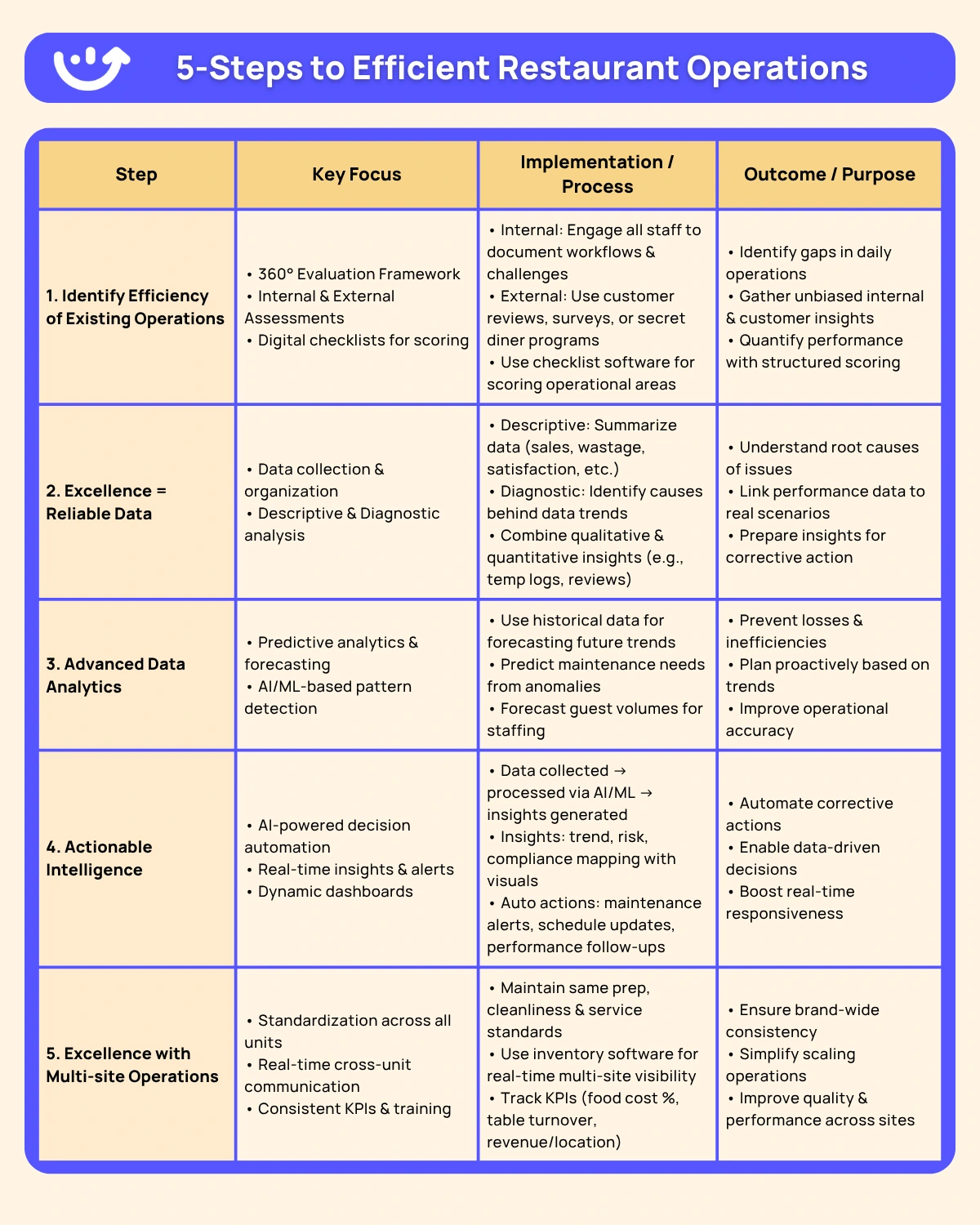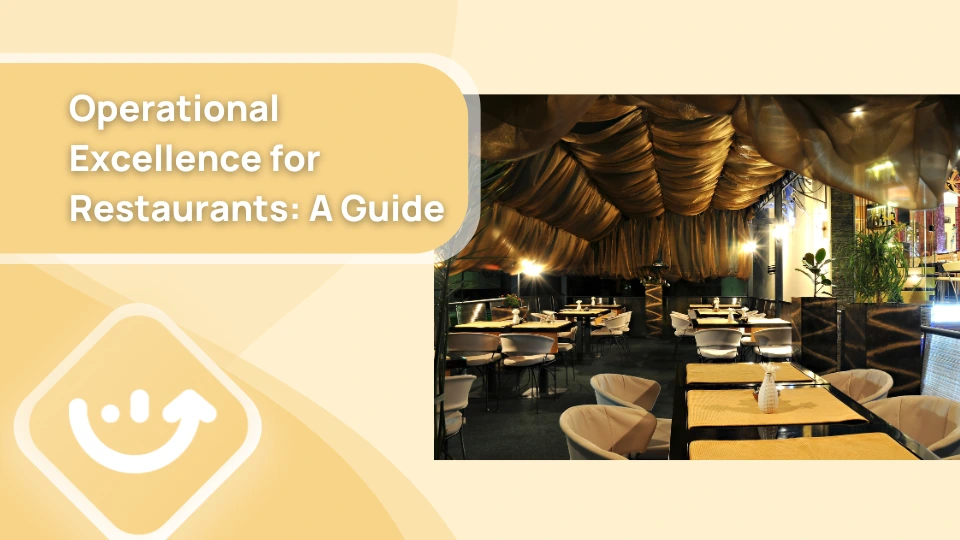Operations for every restaurant differ, but they share the same goal: Profitability, good meals, happy customers, minimal food waste, and scalability. To align these goals, how your daily operations run plays a key role.
The more optimized your operations are, the better your teams will perform, with greater revenue in your sales. In fact, a study by Harvard Business Review states that companies with operational excellence achieve a 25% higher growth and 75% productivity.
But the most important question is: How can you achieve optimized operations that help you improve the performance of your team?
To get your answer, stay tuned!
.svg)

Priced on per user or per location basis
Available on iOS, Android and Web
What is Ops Excellence for Restaurants?
Consider operational excellence (OpEx) as an approach that restaurants adopt to improve their operations.
Let’s say for restaurant A, food quality across two locations varies, making one site profitable. In contrast, the second site faces problems with food safety compliance, poor guest experience, and lower revenue.
Operational excellence will be the approach that strategizes restaurant operations across all the sites to understand where operational gaps exist and how they can be improved.
To achieve operational excellence, businesses follow different methodologies, some of which are listed below:
1. Lean Management focuses on creating workflows that eliminate waste (any resource/activity that does not add value to the service, wastes time, effort, or materials) and delivering what customers truly value. Integrating digital tools into Lean principles helps managers enhance the work processes.
2. Six Sigma is a data-driven business management focused on reducing errors and defects in processes/products. To do so, the methodology depends on statistical analysis, which helps identify problems and remove inconsistencies.
3. Kaizen: Kaizen follows the philosophy of implementing small, ongoing, and constant changes by all employees (from top management to frontline workers), instead of a large-scale execution.
How to Achieve Operational Excellence in Restaurants?
Here’s a 5-step guide that will help you make your operations more efficient.
Also Read: Proven Strategies to Improve Restaurant Operations.

1. Identify the Efficiency of Existing Operations
To evaluate the excellence for restaurant operations, you need to start with a 360° Evaluation Framework, which covers internal and external assessments.
Internal Assessment: Engage all the workflows, including chefs, cashiers, bartenders, hosts, servers, etc., and ask them to document workflows, challenges, guest experiences, and challenges faced.
Start by listing all the operations that take place in your restaurant. From inventory and food preparation to guest service and satisfaction, cover everything. Create various categories if needed, and use a simple point system to evaluate each area (negative points can work wonders). Clean oven? +5 points. Greasy oven? -5.
External Assessment: No matter how efficient and reliable your internal assessments are, how well your operations are performing needs to be evaluated from the customer-facing aspects. And sometimes, the internal assessments can be biased, and external assessments can then be used to measure the quality of your services from the customer's point of view. For this, you can utilize customer reviews, surveys, or opt for a secret diner program.
This might feel overwhelming to do, and so you can also try using a restaurant digital checklist software. The operations execution software helps you build digital checklists, where you can get an overall score for covering every aspect. Like if you are evaluating guest experience, you can get a score based on the quality of your food items or the smallest criteria, like whether the staff has placed napkins at every table or not.
Now you have scores for different operations of your restaurants. But how does that help with achieving excellence for a restaurant? Let’s find out in the next step.
2. Excellence for Restaurants = Reliable Data
Now with evaluations, you have detailed scores for every work process, and now comes the step where you will have to understand what your restaurant operations have been going on.
Here is how to make data useful for your business:
Descriptive Analysis: Summarize all your data—total sales, menu items, food wastage, revenue, customer satisfaction rates, etc. Data management tools can be of great help, first because you get a central platform for storing all your data, and all the information is stored in cloud storage, instead of paper documentation.
At this stage, you will have data values for every operation where you can compare what happened, but based on data. Let's say weekday lunch sales revenue has dropped by 10%.
Diagnostic Analysis: Here, you must identify why it is happening. As we said, weekday lunch sales revenue dropped by 10%. This step will include finding out why it happened. For this example, we can correlate sales trends with data for food wastage, poor weather, or a staff schedule change. In either case, you need to combine qualitative data with quantitative data.
Example:
- A chef has added a comment for stored items being spoiled. To further dig up the cause, you need to check the digital Bluetooth temperature logs. If the temperature log for storage areas suggests any maintenance issues, you can then analyze the financial loss for spoiled raw materials.
- A bad customer review for guest services can lead to a drop in sales because of staff schedule changes, such as the absence of a host, which can next be confirmed with data from employees' check-in and check-out logs.
However, the insights we have right now, after analyzing the data and getting to the root cause, have already happened. What should we do if food wastage caused a total 10% loss in revenue last month? Let's find out in the next step.
3. Advanced Data Analytics
Now you have to use historical data to forecast future events, all with the help of the data you gathered in the first step and your insights from the second step. Next what? Now, predictive analytics tools come into play.
With pre-built AI and ML models, this software is trained to find patterns and relationships within data, which can further predict forecasts and future outcomes.
In our example, the patterns can predict how frequently the storage units need maintenance checks based on temperature anomalies. Alternatively, based on customer data, the AI models can predict guest volumes, ensuring managers can meet the staffing needs accordingly.
4. Actionable Intelligence
At this step, you have patterns and insights that help you know. You have gathered data and you know the patterns. Now comes the most important step to achieve excellence for restaurants, i.e., making decisions and taking action.
You have data-derived proof that storage units are not working properly. The managers can schedule maintenance audits and maintenance. But imagine managers having so many data patterns and forecasts.
How many notifications can you humanly send, or how many audits can you schedule? For this, AI-powered actionable tools can do the work for you.

How Actionable Intelligence Works?
Data is collected from all the sources for different processes, departments, and locations.
The raw data collected is then analyzed, validated, and processed using AI & ML models.
Insights like trend analysis, root cause identification, risk mapping, etc., are recognized by AI models.
The process information is presented in an easy-to-understand way, typically with dynamic dashboards. After analysis, you get insights like heatmaps of incident frequency, risk level, or compliance scoreboards (comparative data across different sites/time periods)
With these actionable insights, operations managers or supervisors can then build strategies that improve operational efficiency
- Detected temperature fluctuations: Real-time alerts are immediately sent to the maintenance teams.
- Changes in staff scheduling in the kitchen: Automated schedule updates for the chefs.
- Unsatisfactory performance: Added follow-ups with photo and location attachments.
If you have one operating unit, the guide ends here, but if you're looking to scale up the restaurant units, here's the last and most important step.
5. Excellence for Restaurants with Multi-site Operations
The last step is to understand how to maintain excellent restaurant operations for all your units.
Scaling a restaurant business can become challenging, with problems like supply chain complexity, operational oversights, and data & quality inconsistencies.
To overcome such problems, each business site’s operations and workflows must be of the same standard, with real-time reporting and communication with other sites to ensure consistency.
You need a central platform that connects not only the internal teams of every unit, but every unit. For instance, the chef from unit A should be able to view what menu the chef from unit B is following.
Here are a few practices that you implement for standard operations across different units:
1. All our processes must follow the same quality, maintenance, and customer service standards. How? Follow the same food preparation methods, recipes, cleanliness & maintenance schedules, portion sizes, and serving policies.
2. Inventory management software can greatly help get real-time data on sales, inventory, stocks, staff, etc., for all locations.
3. Ensure all staff members undergo training for their specialties, like chefs, cleaning staff, etc., to meet the requirements.
4. Decide on KPIs like food cost percentage, table turnover, and revenue per location, and focus on continuous improvement and progress tracking, both independently and collectively.
In fact, restaurants with up to 100 locations have proven records of establishing excellent workflows. Find out how!
Now, let’s see how an operations execution platform helps you achieve operations excellence in the coming section!
Xenia: The Ultimate Tool For Achieving Operational Excellence in Restaurants
.webp)
Xenia is a cloud-based operations execution software that can make your daily restaurant operations, like opening/closing routines, cleaning schedules, food safety compliance, equipment inspections, and inventory tracking, more efficient.
With its customizable digital solutions for monitoring and improving operations, every restaurant can manage all the work orders in one place.
Xenia provides a mobile app, accessible on tablets, ensuring operations are a few taps away. Managers can track all the BOH operations by assigning dedicated tasks to the designated employees, like the chief chef, assistant chef, line cooks, prep cooks, etc.
Learn more about optimizing BOH restaurant operations
Let's understand in brief how Xenia is helping to attain excellence for restaurants:
Temperature Monitoring
Xenia offers integration to Bluetooth thermometers that allow automatic temperature logs and alerts in case something seems off (temperature is not in the right range).
This ensures the food and ingredients are stored at the required temperature. For chefs, it becomes easier to comply with recipe verification as they can record temperature ranges during meal preparation.

Inventory Management
To attain excellence for restaurants, Xenia gives you real-time reports for inventory levels and usage, which reduces the chances of over-ordering or spoilage of food (or prep ingredients).
Xenia supports the FIFO method for the existing stock, which ensures the previously ordered raw materials are used before the new stock, preventing spoilage and food wastage.
Menu Management
Xenia's menu management functionality helps handle planning, rollout, and control tasks. You get a central platform where you can edit, update, and roll out new items in your menu, and it automatically syncs changes for all the operating units.
Similarly, all the food chains can get updated festive or seasonal menus, making operations consistent.
For a limited-time offer (LTO), the regional ops managers can view details like dates, times, and days, allowing all the units to execute the menu rollouts efficiently.
Advanced Analytics
Xenia’s AI-Powered analytics gives you insights and patterns that help you identify risks like food-borne illnesses, food contamination, or similar restaurant safety issues that can reduce operational efficiency.
Xenia's stand-out feature, prep list management, uses existing sales data and current trends to calculate the exact amount of food preparation needed based on forecasted customer volume.

Digital Checklists, Forms, and SOPs
Xenia has a pre-built library with 1000+ templates that you can implement across various locations with little to no customization, helping you standardize tasks for operations across all locations.
And, with Xenia’s AI template builder, you can generate new templates in seconds.
Access ready-to-use templates for different work orders, like:
- Temperature logs
- Food allergen log
- Cleaning and sanitization logs
- Pest control documentation
- Food waste logs
- Inventory tracking with geo-tags and annotation tools
- Food Safety or OSHA Compliance reports
- Cleaning schedules
- Sourcing of raw materials
- Safety & quality inspections
- Audits
- Employee time logs

Food Safety Compliance
Xenia offers the ability to schedule tasks, using which you can automate critical audits and inspections for different time intervals (e.g., every week, month) and usage metrics (e.g., after 100 hours of oven use).
To further meet the prepared food match the safety and quality standards, managers can control & track temperature during food preparation.
Final Thoughts
In this blog, we discussed 5 steps that can help you make your operations perform better and achieve excellence for restaurants. Starting with evaluating your restaurant operations, you must gather and analyze data. With data for all the operations, you can integrate data analytics platforms to find patterns and insights that can predict errors and risks before they happen. The next step is to take action based on your patterns. For multi-unit restaurants, following the same brand standards for all your locations is important.
Restaurant management tools like Xenia offer digital checklists and word order management solutions that ensure consistent brand standards across all locations. Find out how easy it is to implement operational excellence with Xenia's zero-cost 14-day free trial! Try now!
What is operational excellence in a restaurant?
Operational excellence in a restaurant refers to a strategy that helps with the continuous refinement of processes and systems to drive efficiency and productivity. It helps businesses establish consistency in their work processes, improving service quality, cost efficiency, and customer experience.
What makes a restaurant excellent?
An excellent restaurant is defined by its high-quality products, exceptional customer experience, and efficient operations.
How to achieve excellence in a restaurant?
Operations execution platforms like Xenia can help you refine your processes and systems. In addition, you can implement methodologies like Lean Management, Six Sigma, Kaizen, etc., to further enhance overall productivity.

.svg)
.webp)
%201%20(1).webp)





.webp)

.svg)
%201%20(2).webp)








